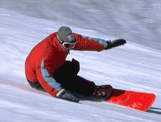

| Fitness Article
of the Month January 1998 Happy and Healthy New Year!! I found this article on a site called the Why Files. A great web site with a lot of little known and interesting health info. The article below deals with athletes losing calcium through sweating. An important study considering the fact that if you don't replace the calcium, bone density seems to suffer. Low fat and nonfat dairy products such as milk, yogurt, cheese, and cottage cheese are some of the calcium rich foods I usually recommend. Credit goes to Robert Klesges, spearheading the study and The Why Files. Best of Health, The Scent Of An Athlete Robert Klesges,
a preventive medicine specialist at University of Memphis, says
his research into the relationship between sweat and bone thinning
began innocently enough: "We found something unexpected and
followed our noses." Klesges singled
out a university basketball team for study and ruled out the possibility
that disease was causing the bone loss. Klesges, director of the
University of Memphis Prevention Center, knew the players were losing
six or more pounds of sweat during a three-hour workout, and wondered
how much calcium was being lost in that sweat. Since nobody had ever collected athletic sweat for analysis, Klesges had to start by inventing a collection contraption. He says his first effort bore a resemblance to a sanitary napkin and was immediately nixed. The players did, however, consent to wear a cotton tee-shirt for the first hour of practice. It wrings true Then came the fun part. As Klesges and colleagues described it in the medical journal JAMA ("Changes in Bone Mineral Content...", 17 July 1996, p. 226-30), "The shirt was then removed by a research assistant (The Why Files bet it was a lucky grad student, but Klesges insists he did it too) wearing rubber gloves and placed in a sterile plastic container." The sweat was extracted and its calcium content measured in a mass spectrometer. Knowing the percentage of calcium in the samples and how much sweat the players lost during practice, Klesges calculated that they were losing an average of 422 milligrams of calcium during three days' training. Measurements of bone density showed that the average player lost 3.8 percent of bone mineral density during the three months between preseason and midseason. Klesges says this is a significant amount, which explains the stress fractures seen in the team and may even predispose the athletes to osteoporosis later in life. Complicated calculus of calcium Having documented that loss, the researchers tried to reverse it by asking the athletes to consume a calcium-rich sports drink and other calcium supplements. The treatment worked: during the start of the second season, the athletes actually gained an average of 2 percent in bone mineral densities. Klesges says the research is one more demonstration that while exercise alone cannot help bones stay dense and strong, moving your bones can be good for them -- if you get enough calcium. He adds that a recent reanalysis of dozens of studies showed that "exercise was related to increased bone mass only if calcium intake was sufficient." Are you getting enough calcium? The U.S. recommended daily allowance has just been raised; depending on your age and gender, it can range from 1,000 to 1,300 milligrams, according to the U.S. Institute of Medicine. This fitness article is for educational purposes only. It is not medical advice and is not intended to replace the advice or attention of health-care professionals. Consult your physician before beginning or making changes in your diet, supplements or exercise program, for diagnosis and treatment of illness and injuries, and for advice regarding medications. Thanks. RM |
|
Copyright 2001, Ron McConnell. All rights reserved. |
